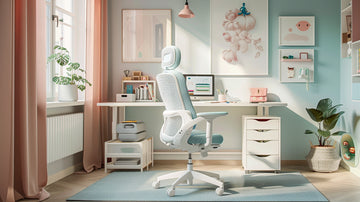Introduction
Back pain is a common problem that affects millions of people. It can range from mild discomfort to debilitating pain that interferes with daily activities. There are many potential causes of back pain, including injuries, muscle strains, arthritis, compressed nerves, and more. One major contributor to back pain that often goes overlooked is poorly designed office chairs.
An ergonomic chair is designed to provide proper support for your back and promote a healthy sitting posture. Ergonomics is the science of designing furniture, equipment, and workspaces to fit the human body and promote overall health and wellbeing. An ergonomic office chair has adjustments and features that reduce strain on your back and can help alleviate or prevent back pain.
In this article, we will explore the causes of back pain, how traditional office chairs contribute, the key features of ergonomic chairs, and the specific benefits an ergonomic chair can provide for improving back pain and posture. We'll also cover tips for choosing the right ergonomic chair and making other lifestyle changes to further relieve back pain.
Causes of Back Pain
Back pain can stem from a variety of causes that affect the muscles, bones, nerves, or discs in your spine. Some of the most common reasons people experience back pain include:
- Poor posture - Slouching, hunching over, or straining your neck forward can put extra pressure on your back muscles and spine. Maintaining proper posture can help reduce back strain.
- Lack of exercise - Weak back and abdominal muscles can't properly support the spine. Regular exercise to build core strength helps prevent and alleviate back pain.
- Injuries - Accidents, falls, and improper lifting can sprain muscles or cause fractured vertebrae. Sports injuries are a common cause of back pain in athletes and active individuals.
- Obesity - Excess weight, especially around the abdomen, increases the load on the spine and pressure on the vertebrae and discs.
- Strenuous physical labor - Jobs that involve heavy lifting, pushing, pulling or twisting can overwork the back muscles and cause injury over time.
- Stress and anxiety - Mental strain and tension can manifest physically as muscle tightness and spasms in the back.
Pinpointing and addressing the root cause is key to finding lasting relief from back pain.
How Office Chairs Contribute
Many traditional office chairs lack proper back support and can put strain on the spine. The shape of standard office chairs does not match the natural S-curve of the spine, forcing you to slouch forward into improper posture.
Office chairs often have minimal padding or thin cushions that do not adequately support the back. Sitting for prolonged periods on hard, uncomfortable surfaces causes strain on the structures of the spine.
Most office chairs also do not adjust to properly align with the spine's natural curvature. The fixed shape forces the lower back into a rounded position that stresses the ligaments and muscles over time.
Sitting motionless in conventional chairs also fails to engage the back muscles, allowing them to become weak. This lack of muscle activation worsens posture and back pain.
Without lumbar support, the lower back is under constant pressure in traditional office chairs. This can compress the discs and joints, leading to inflammation and pain.
Ergonomic Chair Features
Ergonomic office chairs are designed with specific features to help improve posture and reduce back pain. Here are some key features to look for:
Lumbar support - Most ergonomic chairs have built-in lumbar support or an adjustable lumbar cushion to support the natural curve of your lower back. This helps you maintain proper spinal alignment while sitting.
Adjustable height - Chairs with pneumatic seat height adjustment allow you to raise or lower the seat to find the optimal position for you. Your thighs should be parallel to the floor with your feet flat.
Adjustable armrests - Look for armrests that you can adjust up/down, in/out to support your arms without hunching your shoulders. This reduces strain on the upper back.
Recline and tilt - Reclining backrests and tilting seats allow you to shift positions and maintain neutral pelvis alignment.
Breathable materials - Mesh back and fabric seats help prevent heat buildup and sweat compared to solid foam or leather.
The right ergonomic chair provides customized support and movement to accommodate people of all sizes and shapes.
Benefits for Your Back
An ergonomic chair can provide immense benefits for your back pain by improving your posture and reducing strain on your spine. When seated in a regular chair, it's easy to slouch over or sit in a crunched position, causing tension in your back muscles. But an ergonomic chair is designed to encourage proper spinal alignment.
Ergonomic chairs have built-in lumbar support that fills the natural curve of your lower back. This takes pressure off your discs and spinal muscles. The backrest reclines to open up the angle between your torso and thighs, reducing disc compression. This improves the curvature of your spine to alleviate muscle tightness.
The seat design also reduces strain. Chairs are wider to support your hips and thighs in proper alignment. The front of the seat has a waterfall edge to remove pressure under your legs. This further helps you maintain proper posture instead of slumping forward.
With these tailored design elements, an ergonomic chair properly positions your back to reduce muscle fatigue. Your spine stays in a neutral, relaxed position rather than a strained, hunched posture. Over time, this can decrease back pain and soreness substantially.
Other Health Benefits
In addition to alleviating back pain, using an ergonomic chair can provide many other health benefits:
Less Neck and Shoulder Pain: Ergonomic chairs are designed to promote proper spine alignment and posture, which takes pressure off your neck and shoulders. Sitting in a hunched position can strain muscles in the neck and shoulders, leading to chronic pain over time. An ergonomic chair with lumbar support, adjustable armrests, and headrest can help keep your neck and shoulders relaxed.
Improved Circulation: Chairs that allow you to adjust your seat height and position your knees at a 90-90-90 degree angle (hips, knees and ankles at 90 degree angles) encourage better blood flow. This takes pressure off the undersides of your thighs, which can restrict circulation to your legs and feet when sitting for prolonged periods.
Reduced Fatigue: Ergonomic chairs are designed to provide optimal support and comfort, allowing you to sit for longer without getting tired. Features like lumbar support, tilt controls, and cushioned seats distribute your weight evenly and let you change positions, resulting in less fatigue. This helps you stay energized and focused throughout the workday.
Lower Risk of Varicose Veins: Sitting with poor posture and pressure on the undersides of your thighs can increase the risk of developing varicose veins in your legs. Ergonomic chairs improve circulation and reduce pressure points, lowering your risk.
Stress Relief: Being uncomfortable at your desk can cause stress and tension. An ergonomic chair optimizes comfort, provides customizable support, and reduces strain on your body, helping you feel more relaxed as you work. This can lower cortisol levels and ease anxiety.
Tips for Choosing a Chair
When shopping for an ergonomic office chair, there are a few key factors to consider:
- Adjustability - Look for a chair that allows you to adjust the seat height, backrest angle, armrest height and depth. The more adjustable parts the better, as you can customize it to fit your body.
- Lumbar support - A quality ergonomic chair will have an adjustable lumbar support feature to properly support the natural curve of your lower back.
- Seat depth - Make sure the chair seat isn't too long or short for your thighs. You want about 2-4 inches between the back of your knees and the seat edge.
- Recline function - An option to recline the backrest lets you shift positions throughout the day and take pressure off your spine.
- Armrests - Check that the armrests don't obstruct your work surface when lowered and allow you to get close to your desk.
- Material - Breathable mesh fabric can help prevent heat buildup versus leather chairs.
- Test it out - Sit in display chairs at the store for at least 10-15 minutes to gauge comfort and support.
- Set up properly - When installing your new chair, adjust the settings to suit your body. Consult the user guide as needed.
Finding the right ergonomic chair is crucial for maximizing back support during long office hours. Take the time to test options and fine-tune the adjustments for your own comfort.
Making Additional Lifestyle Changes
While an ergonomic chair can help alleviate back pain caused by poor posture, you may need to make additional lifestyle changes for the best results. Here are some tips:
Get regular exercise. Low-impact activities like walking, swimming, or yoga can strengthen your back and core muscles. Aim for at least 30 minutes per day.
Stretch frequently. Simple stretches for your lower back, hips, and hamstrings can limber up tight muscles that contribute to back pain. Try doing a few stretches when you wake up, at lunch, and before bed.
Set up your workstation properly. Position your computer screen at eye level and place your keyboard at elbow height to maintain good posture. Your knees should be slightly below your hips when you sit. Get a footrest if needed.
Watch your weight. Excess weight puts more pressure on your lower back. Losing even a few pounds can relieve back pain if you are overweight.
Practice good posture. Whether sitting, standing, or moving, be mindful of keeping your back aligned and your core engaged. Don't slouch when standing or sitting.
Wear supportive shoes. Shoes with good arch support and shock absorption can take pressure off your back when you're on your feet.
Sleep on your side or back. Sleeping on your stomach can twist your neck and spine. Place a pillow between your knees or under them to maintain spinal alignment.
Manage stress. High stress can lead to muscle tension and spasms in your back. Try relaxing activities like meditation, massage, or yoga.
When to Seek Medical Care
While minor back pain often resolves on its own, it's important to know when to see a doctor. You should schedule an appointment if you experience:
- Unexplained weight loss along with back pain
- Back pain after a major trauma like a car accident
- Loss of bowel or bladder control
- Numbness in the legs or buttocks
- Back pain with fever over 102°F (39°C)
- Pain, numbness or weakness in the legs
- Back pain that persists for more than a few weeks
- Severe unexplained back pain
Seeing a doctor can help determine if your back pain is related to an underlying medical condition. They may order imaging tests or blood work to diagnose serious issues. Prompt treatment may be needed for conditions like infections, cancer or cauda equina syndrome.
Don't hesitate to make an appointment if your back pain concerns you. Early diagnosis leads to better outcomes.
Conclusion
An ergonomic chair can provide a variety of benefits for individuals suffering from back pain. With the proper adjustments, ergonomic chairs can improve posture and provide critical lumbar support. Key features like adjustable seat height, tilt tension, armrests, and lumbar support all aim to create a comfortable sitting experience that takes pressure off the back.
By aligning the spine and reducing strain, an ergonomic chair can help relieve muscle tension and soreness in both the back and neck. This can lead to reduced pain, improved mobility, and better long-term back health. The customizable nature of a quality ergonomic chair makes it possible to find a fit that works for your body type and preferences.
While an ergonomic chair alone may not completely eliminate back pain, it can be an integral part of an overall wellness routine. Combined with regular exercise, proper desk ergonomics, and healthy lifestyle choices, an ergonomic chair can help maximize comfort while you sit and minimize the impact that work has on your back health. The investment is well worth it for the potential improvements in your daily comfort and long-term wellbeing.






